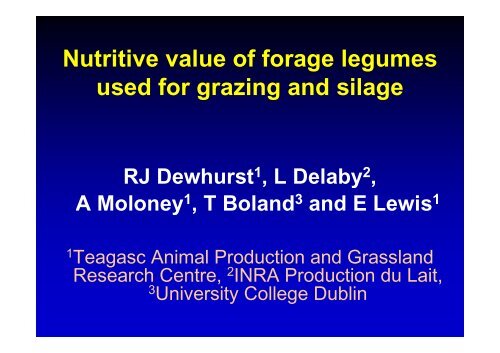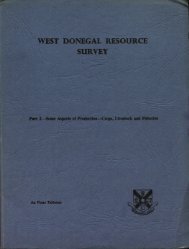Nutritive value of forage legumes used for grazing and silage – R.J. ...
Nutritive value of forage legumes used for grazing and silage – R.J. ...
Nutritive value of forage legumes used for grazing and silage – R.J. ...
Create successful ePaper yourself
Turn your PDF publications into a flip-book with our unique Google optimized e-Paper software.
<strong>Nutritive</strong> <strong>value</strong> <strong>of</strong> <strong><strong>for</strong>age</strong> <strong>legumes</strong><br />
<strong>used</strong> <strong>for</strong> <strong>grazing</strong> <strong>and</strong> <strong>silage</strong><br />
RJ Dewhurst 1 , L Delaby 2 ,<br />
A Moloney 1 , T Bol<strong>and</strong> 3 <strong>and</strong> E Lewis 1<br />
1 Teagasc Animal Production <strong>and</strong> Grassl<strong>and</strong><br />
Research Centre, 2 INRA Production du Lait,<br />
3 University College Dublin
Outline <strong>of</strong> talk<br />
• Production responses<br />
• Digestion <strong>and</strong> feed intake<br />
• Product quality <strong>–</strong> fatty acids<br />
• Environment <strong>–</strong> nitrogen, methane<br />
• Health <strong>–</strong> bloat<br />
• Fertility<br />
• Concluding remarks
Milk yield (kg/d)<br />
Legume <strong>silage</strong>s: milk yield<br />
35<br />
30<br />
25<br />
20<br />
15<br />
10<br />
SED=1.81; P
Legume <strong>silage</strong>s: lamb growth<br />
la m b g r o w th r a te ( g /d )<br />
400<br />
300<br />
200<br />
100<br />
0<br />
Grass Red clover<br />
Fraser et al. 2004
Milk yield (kg/d)<br />
Grazed white clover: milk yield<br />
30<br />
25<br />
20<br />
15<br />
10<br />
5<br />
0<br />
Ribeiro<br />
Filho et al.<br />
2003<br />
Ribeiro<br />
Filho et al.<br />
2003<br />
Phillips &<br />
James<br />
1998<br />
PRG<br />
PRG/WC<br />
Phillips et<br />
al. 2000
Digestibility <strong>of</strong> legume <strong>silage</strong> diets<br />
Diet digestibility (%)<br />
80<br />
75<br />
70<br />
65<br />
60<br />
55<br />
50<br />
Grass 50%<br />
Red<br />
clover<br />
SED=0.96; P
DMI <strong>of</strong> legume <strong>silage</strong>s: cows<br />
Silage DM intake (kg/d)<br />
15<br />
14<br />
13<br />
12<br />
11<br />
10<br />
9<br />
8<br />
SED=0.80; P
DMI <strong>of</strong> legume <strong>silage</strong>s: lambs<br />
D ry m a tte r in ta k e<br />
(k g /d )<br />
3<br />
2<br />
1<br />
0<br />
Grass Red clover<br />
Fraser et al. 2004
DMI: grazed ryegrass/white clover<br />
DM intake (kg/day)<br />
15<br />
13<br />
11<br />
9<br />
7<br />
5<br />
0 50 100<br />
% white clover<br />
Expt. 1<br />
Expt. 2<br />
Harris et al. 1998
DM degraded (%)<br />
100<br />
80<br />
60<br />
40<br />
20<br />
0<br />
rate ‘c’<br />
0 10 20 30 40 50<br />
Time (hours)<br />
‘b’ fraction<br />
‘a’ fraction
DM degradation (a <strong>and</strong> b fractions; %)<br />
%<br />
60<br />
50<br />
40<br />
30<br />
20<br />
10<br />
0<br />
a b<br />
G FI<br />
RC FI<br />
G SE<br />
RC SE<br />
WC SE<br />
G UK<br />
RC UK<br />
WC UK
DM degradation rate (c; per hour)<br />
0.14<br />
0.12<br />
0.1<br />
0.08<br />
0.06<br />
0.04<br />
0.02<br />
0<br />
G FI<br />
RC FI<br />
G SE<br />
RC SE<br />
WC SE<br />
G UK<br />
RC UK<br />
WC UK
Rumen passage rate (%/hour)<br />
6<br />
5<br />
4<br />
3<br />
2<br />
1<br />
0<br />
SED=0.61 P
proportion <strong>of</strong> rumen DM (g/kg)<br />
500<br />
450<br />
400<br />
350<br />
300<br />
250<br />
200<br />
150<br />
100<br />
50<br />
0<br />
SED=0.024; P
White clover<br />
• High fermentation rate<br />
• High rumen passage rate<br />
• High intake<br />
• High milk/DM intake<br />
Lucerne<br />
• Rapid particle breakdown<br />
• High rumen passage rate<br />
• High intake<br />
• Low milk/ DM intake
• May:<br />
Changes in digestibility<br />
<strong>–</strong> Perennial ryegrass: -20 g/kg DM<br />
<strong>–</strong> White clover: -10 g/kg DM<br />
• Later rotations (28 to 42 d regrowth):<br />
<strong>–</strong> Perennial ryegrass: -20 g/kg DM<br />
<strong>–</strong> White clover: no decline<br />
Giovanni, 1990
Outline <strong>of</strong> talk<br />
• Production responses<br />
• Digestion <strong>and</strong> feed intake<br />
• Product quality <strong>–</strong> fatty acids<br />
• Environment <strong>–</strong> nitrogen, methane<br />
• Health <strong>–</strong> bloat<br />
• Fertility<br />
• Concluding remarks
Red clover effect on milk PUFA<br />
% <strong>of</strong> milk fatty acids<br />
1.6<br />
1.4<br />
1.2<br />
1<br />
0.8<br />
0.6<br />
0.4<br />
0.2<br />
0<br />
SED=0.05<br />
P
Alpha-linolenic acid in organic milk<br />
linolenic acid (% <strong>of</strong> milk fat)<br />
0.8<br />
0.7<br />
0.6<br />
0.5<br />
0.4<br />
0.3<br />
0.2<br />
0.1<br />
0<br />
SED=0.084; P
Polyphenol oxidase in red clover<br />
Normal Red Clover Low PPO Red Clover
PPO <strong>and</strong> lipolysis in red clover<br />
Free fatty acids (g/g)<br />
0.12<br />
0.08<br />
0.04<br />
0.00<br />
low PPO<br />
normal PPO<br />
0 2 4 6 8 10 12 14<br />
Time (Hours)<br />
Lee et al., 2004
Herbage composition (<strong>for</strong> ensiling)<br />
g/kg DM<br />
600<br />
500<br />
400<br />
300<br />
200<br />
100<br />
0<br />
Perennial ryegrass<br />
White clover<br />
Red clover<br />
Crude protein Water-soluble<br />
carbohydrates<br />
NDF
Legume <strong>silage</strong>s: N-use efficiency<br />
Milk-N / feed-N (%)<br />
30<br />
28<br />
26<br />
24<br />
22<br />
20<br />
18<br />
16<br />
14<br />
12<br />
10<br />
Grass 50%<br />
Red<br />
clover<br />
SED=0.15; P
Milk <strong>and</strong> Urine N output (g/day)<br />
180<br />
160<br />
140<br />
120<br />
100<br />
80<br />
60<br />
40<br />
20<br />
0<br />
Grass <strong>silage</strong> 40% red clover<br />
60% maize<br />
Milk N<br />
Urine N<br />
25% red clover<br />
75% maize
Methane<br />
• Usually lower <strong>for</strong> animals fed <strong><strong>for</strong>age</strong><br />
<strong>legumes</strong><br />
• Variety <strong>of</strong> mechanisms:<br />
<strong>–</strong> Lower fibre content<br />
<strong>–</strong> Higher DM intakes<br />
<strong>–</strong> Higher passage rates (reduced residence)<br />
<strong>–</strong> Secondary plant metabolites such as<br />
condensed tannins in some <strong>legumes</strong>
Bloat<br />
• Problem with RC, WC <strong>and</strong> LUC<br />
• Formation <strong>of</strong> slime traps gas leading to<br />
rumen distension<br />
• Complex aetiology linked to soluble protein<br />
<strong>and</strong> small particles in these <strong>legumes</strong><br />
• Animals vary in susceptibility <strong>–</strong> related to<br />
saliva production <strong>and</strong> rumen kinetics<br />
• Condensed tannins make <strong>legumes</strong> bloat<br />
safe, but Lotus has agronomy issues
Effect <strong>of</strong> red clover on fertility?<br />
• Contains phyto-oestrogens, particularly<br />
<strong>for</strong>mononetin, that can interfere with<br />
reproductive cycles<br />
• Sheep are sensitive to these compounds<br />
• Only two studies with dairy cows <strong>–</strong> both<br />
increased first service conception rate
Effects <strong>of</strong> red clover <strong>silage</strong> on<br />
conception rate <strong>of</strong> heifers<br />
pregnancy rate to<br />
first service (%)<br />
Grass<br />
<strong>silage</strong><br />
Red clover<br />
<strong>silage</strong><br />
43 76<br />
Austin et al., 1982
Possible mechanism <strong>for</strong> effect<br />
<strong>of</strong> red clover on fertility?<br />
• Modern red clover varieties are lower in<br />
phyto-oestrogens<br />
• Cows less sensitive to phyto-oestrogens<br />
• High intake <strong><strong>for</strong>age</strong> promotes better cow<br />
condition<br />
• Better supply <strong>of</strong> n-3 fatty acids (affects<br />
prostagl<strong>and</strong>in metabolism)
Concluding remarks<br />
• Legumes usually increase milk or meat<br />
production, whether grazed or fed as <strong>silage</strong><br />
• Main effect through increased intake, linked to<br />
high rumen digestion <strong>and</strong> passage rates<br />
• Other benefits: increased milk PUFA; reduced<br />
methane; cow fertility?<br />
• Hazards: bloat; high urine Nitrogen<br />
• Beneficial traits in other <strong>legumes</strong> (e.g. Lotus) <strong>–</strong><br />
but not well adapted here



